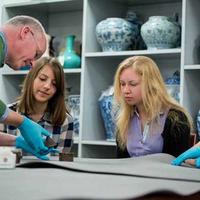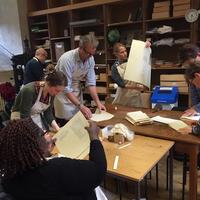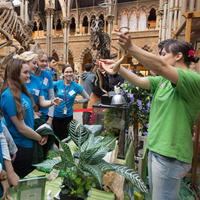GLAM PCER Toolkit: Getting started
Step 1: Are you new to PCER or would like to develop your skills?
Find out more about support for public and community engagement with research at the University including the 'New to Oxford' PCER Buddy Scheme, evaluation training and PCER training that is provided by Oxford University’s central Public and Community Engagement team and the academic divisions.
It is recommended that researchers contact their departmental/Divisional PCER facilitator for support/guidance, particularly if new to PCER.
Find out more about PCER activity and support in the academic divisions of the University:
- Mathematical, Physical and Life Sciences Division (MPLS)
- Medical Sciences Division
- Social Sciences Division
- The Oxford Research Centre in the Humanities (TORCH)
Much of the ‘Getting started' content on this page is taken from Oxford University’s central PCER webpages, which contain a great deal of useful advice and information. The University College London (UCL) Engagement webpages are also very helpful.
For an initial chat about PCER opportunities with GLAM, particularly for activities spanning more than one GLAM institution, researchers may also wish to contact Hattie Warburton (harriet.warburton@glam.ox.ac.uk) or Emma Webster (emma.webster@glam.ox.ac.uk) in the GLAM Research and Impact Management team.
For comments/feedback/questions about the GLAM PCER Toolkit please contact Emma Webster (emma.webster@glam.ox.ac.uk).
GLAM institutions can offer researchers access to their unique collections and support them to develop skills and confidence in using them as a research resource.
GLAM can also support the development of skills in public and community engagement with research. Expert staff can guide researchers through the development and delivery of consultation and engagement activities, using the GLAM collections as a catalyst.
The examples of training opportunities within GLAM below are about academic engagement using GLAM’s collections but please note that a wealth of tailored PCER training is also offered via PCER facilitators within the academic divisions (see links above).
There is a New to PCER? category in the GLAM PCER Toolkit which lists activities which are particularly suitable for early career researchers and those new to PCER.
Click here to join the GLAM PCER mailing list to be informed about upcoming opportunities.

Ashmolean Museum
University and Academic Engagement
The Ashmolean has become a key centre for faculty members and early career researchers to develop their skills in object-based teaching and learning. The Museum’s University and Academic Engagement team can provide opportunities to engage more deeply with the products of material and visual culture.
Example: Eloquent Things: Teaching Using Real Objects
Contact: University and Academic Engagement team (UAE@ashmus.ox.ac.uk)

Bodleian Libraries
The Centre for the Study of the Book, Weston Library
Based in the Weston Library, the Centre for the Study of the Book hosts classes with books for regular university courses, master classes from invited speakers examining early and rare material, workshops bringing together researchers, curatorial and conservation staff, and academic lectures and seminars focussing on the Bodleian Library’s special collections. In collaboration with the Centre for Digital Scholarship, Bodleian Student Editions workshops engage students from across the university in making digital transcriptions from original manuscripts. The library’s printing studio hosts classes learning historical printing.
Researchers can schedule a class session with special collections or can ask for a consultation to explore ways of engaging with original manuscripts and early printed materials in the communication of your research.
Example: A virtual tour of Dante 1481
Contact: Centre for the Study of the Book (bookcentre@bodleian.ox.ac.uk)

History of Science Museum
Collections and archive access for research and teaching
The History of Science Museum (HSM) is the home of the history of science in Oxford. HSM is also the repository for one of the finest collections of scientific instruments from the Islamic world and for their accompanying provenance and research materials collected over the last century.
Researchers interested in the production of knowledge and the development of scientific techniques at the University would be welcome to use the collections for these purposes.
Example: Creating and curating a special exhibition blog post
Contact: Collections team (collections@hsm.ox.ac.uk)

Oxford University Museum of Natural History
The Museum of Natural History offers structured training sessions for researchers planning to support family events such as Super Science Saturday. Such events provide opportunities for the public to engage with some of the world-class research that goes on within the University.
Researchers can develop and practise their science communication skills in a supportive environment, with assistance from experienced museum staff and volunteers.
Example: Super Science Saturday
Contact: Education Officer: Secondary (Art), Families & Young People (carly.smith-huggins@oum.ox.ac.uk)

Pitt Rivers Museum
Behind-the-scenes workshops for researchers
Behind-the-scenes workshops and daytime events led by Museum staff can be tailored to particular research interests and training needs. They are facilitated by the museum's public engagement team and an Assistant Curator with an option to work with a Senior Curator at extra cost.
Researchers, research teams and/or a mix of researchers and their stakeholders can gain bespoke access to a specific part of the collection depending on their interests and training needs.
Example: Series of training workshops with early career researchers leading to digital outputs for PCER (film and new items of CABINET)
Contact the museum for further information (prm@prm.ox.ac.uk)
Step 2: Planning the activity
High-quality public and community engagement with research is a two-way process which aims to generate mutual benefit for the public and researchers and ultimately enhance the quality or impact of research.
The key to successful public and community engagement with research (PCER) or ‘engaged research’ activity is planning: it is important for researchers to think about why they want to engage and who they want to engage before deciding how they’re going to do it. Ideally public and community engagement should be thought about in parallel with the design of the research activity. The aim should be to prioritise those engagement activities that will most effectively enhance the quality or impact of the research.
Find out more about support for Public and Community Engagement at the University including training available to help you develop your activity from the University of Oxford’s Public and Community Engagement team and within the academic divisions.
The National Co-ordinating Centre for Public Engagement website also contains guidance and best practice recommendations on how to plan, fund, deliver and evaluate your public and community engagement activities, as well as information on developing your skills.
Researchers are reminded to be aware of the need for risk assessments, capacity and security when planning on-site activities; GLAM staff will be able to advise on this. Further guidance can be found in the Event management pages of the Oxford University website.
The first question to think about when planning an activity is: Why do you want to engage the public?
The three purposes of public and community engagement with research are:
- to inform and inspire the public (e.g. talks, exhibitions)
- to consult and listen to public views (e.g. public debates, focus groups)
- to collaborate with the public (e.g. Citizen Science, co-production of knowledge)
(For info, the NIHR provides a useful overview of how PCER differs from PPI (Public Patient Involvement) on its ‘What is Patient and Public Involvement and Public Engagement?’ webpage. Further information about PPI can be found on the Patient and public involvement (PPI) in research page of Oxford University’s Primary Care website.)
It is important for researchers to articulate the aims of the PCER activity clearly before they start so that the activity can be evaluated properly, i.e. did the activity achieve the stated aims?
The National Co-ordinating Centre for Public Engagement (NCCPE) website contains useful information about how to think about the purpose of the engagement.

Researchers may also find it useful to think about Arts Council England’s five generic learning outcomes below and what changes are trying to be achieved.
Note that the most effective activities usually focus on one or two changes to make rather than trying to achieve all the learning outcomes in the diagram.
As well as thinking about the potential impact of your research, researchers need to consider which audiences they are trying to engage. This will depend on the nature of the research and the reasons for the engagement.
Audiences for public and community engagement with research activities within Oxford University's Gardens, Libraries and Museums could include any or all of the following:
- Adults
- Community groups and special interest groups
- Families
- Higher education
- Primary schools
- Secondary schools
- Special educational needs and disabilities (SEND) groups
- Young people
Staff across the GLAM institutions have a wealth of experience working with different types of audiences. We recommend that researchers get in touch as early as possible in the planning process to start thinking about how best to engage.
Step 3: Practical considerations
Examples of opportunities for public and community engagement with research within Oxford University's Gardens, Libraries and Museums, as well as estimates of costs and useful contacts, can be found in GLAM PCER Toolkit: Opportunities by category and GLAM PCER Toolkit: Opportunities by institution. (Please note that opportunities are subject to change.)
The general rule of thumb is to contact the relevant team as early as possible to discuss ideas and involvement.
Oxford University’s Gardens, Libraries and Museums (GLAM) house some of the world's most significant collections, covering the breadth and depth of the natural world and global human experience.
The overview of GLAM institutions below contains information about each GLAM institution as well as links to their websites.
The ‘Collections’ page of the GLAM website contains an overview of this exceptional resource.
The GLAM institutions operate both individually and collaboratively, and there may be scope for PCER activities that are cross-institutional. For example, the Museum of Climate Hope trail across GLAM aims to encourage positive engagement with environmental change among young people and was created by researchers from the University's Environmental Change Institute (ECI) in collaboration with GLAM. Researchers should contact the relevant teams to start discussions about what may be possible.
The general rule of thumb is to contact the relevant team as early as possible to discuss ideas and involvement.
Different activities have different lead-in times, some much longer than others. For example, exhibition planning can take as long as five years in advance for exhibitions at GLAM institutions (and costs can vary from a few thousand pounds to tens of thousands of pounds).
Activities often involve working in collaboration with partners external to GLAM, therefore it is advisable for researchers to contact the relevant team at the institution at the earliest possible convenience.
Time and resources will be required for training staff and building awareness of new products and opportunities. Lead time for the recruitment, training and induction of volunteers needs to be considered.
Any projects which are being included in research funding applications will need to be discussed well in advance of the funder deadline.
The general rule of thumb is to contact the relevant team as early as possible to discuss ideas and involvement.
Please be aware that GLAM venues have full and busy programmes and it may not be possible to pick up activities that have already been fully developed or to deal with urgent requests. Ideally, activities should be co-created with GLAM from project conception and researchers should get in contact early so that we can work together to develop your ideas.
Please note that while researchers may contact GLAM departments directly they are also encouraged to contact departmental/Divisional PCER facilitators for interim support/guidance.
Costs for public and community engagement with research can vary from very little (just the researcher and their research) to thousands of pounds.
GLAM PCER Toolkit: Opportunities for researchers gives some information about potential costs. All planned activities need to be discussed well in advance with the department’s relevant team so that unexpected costs do not cause problems down the line. Again, the general rule of thumb is to contact the relevant team as early as possible to discuss costs.
Staff costs may be given ‘in-kind’ by the GLAM institution in question or may need to be costed into research funding applications (for example, for any Visitor Experience Assistance and/or retail team cover required for out-of-hours events), especially UKRI grants which require Full Economic Costing. If staff costs are involved then a costing may need to be created in X5, the University’s costing and pricing tool.
Contact Hattie Warburton (harriet.warburton@glam.ox.ac.uk) or Emma Webster (emma.webster@glam.ox.ac.uk) in the GLAM Research and Impact Management team if an X5 costing is required for staff costs.
To help save on costs, PERShare is a platform where you can borrow and offer public and community engagement with research items, including audio-visual equipment and furniture; the site is managed by Oxford University's MPLS Division.
Researchers are encouraged to include costs for public and community engagement with research activities into funding applications where possible.
The University of Oxford offers internal funding towards public and community engagement with research for its staff, including:
- Public and Community Engagement with Research Fund
- ESRC Impact Acceleration Account at Oxford (managed by the Social Sciences (SSD) Division)
- EPSRC Impact Acceleration Account (managed by the Mathematical, Physical, and Life Sciences (MPLS) Division)
The National Co-ordinating Centre for Public Engagement website also contains a useful list of funding opportunities available to support public and community engagement activities.
It is helpful to think about why the activity is being done and how in order to understand the kinds of impact that could be achieved.
To be deemed public and community engagement with research the impact needs to be with the public rather than within academia; the definition of impact for the 2021 Research Excellence Framework (REF) was as follows:
“An effect on, change or benefit to: Economy; Society; Culture; Public Policy, Services, Health, the Environment or Quality of Life……..beyond academia”.
Annex A of the panel criteria guidance for REF 2021 (Research Excellence Framework 2021) contains a useful list of examples of areas and types of impacts ‘beyond academia’ as well as examples of ways to evidence these.
The GLAM Divisional Office Research and Impact team has a dedicated Evaluation Officer, Felicity McDowall (felicity.mcdowall@glam.ox.ac.uk), who can consult with researchers at an early stage about the most appropriate forms of evaluation and any associated costs.
There are various tools available to help researchers measure the impact of public and community engagement with research activities. The GLAM Divisional Office evaluation guidance SharePoint site (requires Oxford SSO) contains a PCER evaluation toolkit, online evaluation guide, and GLAM PCER evaluation reports.
The University’s Public and Community Engagement with Research team can also advise on evaluation methods and tools. They have drawn together some useful evaluation resources on the University’s Research Support webpages for researchers, DPhil students and professional services staff for evaluation of public and community engagement with research and gathering evidence of impact. Videos 1 (planning evaluation), 2 (evaluation methods), and 3 (shared learning) are a great go-to first step towards learning about evaluation and are in three chunks to be smaller and more manageable.
If you are interested in joining or using the pool of evaluation-trained volunteers for your activity, or just want to find out more about possibilities for PCER evaluation with GLAM, contact Felicity McDowall (felicity.mcdowall@glam.ox.ac.uk) for more information.
The general rule of thumb is to contact the relevant team as early as possible to discuss ideas and involvement.
Step 4: Find out more about GLAM institutions and get in touch
Oxford University’s Gardens, Libraries and Museums (GLAM) house some of the world's most significant collections, covering the breadth and depth of the natural world and global human experience. The ‘Collections’ page of the GLAM website contains an overview of this exceptional resource. The section below contains information about each GLAM institution as well as links to their websites.
Please be aware that GLAM venues have full and busy programmes and it may not be possible to pick up activities that have already been fully developed or to deal with urgent requests. Ideally, activities should be co-created with GLAM from project conception and researchers should get in contact early so that we can work together to develop your ideas. Please note that while researchers may contact GLAM departments directly they are also encouraged to contact departmental/Divisional PCER facilitators for interim support/guidance.

The University of Oxford’s museum of art and archaeology was founded in 1683. Its world-famous collections range from Egyptian mummies to contemporary art, telling human stories across cultures and across time.
Contact: PER Coordinator, Zoe Bampton (zoe.bampton@ashmus.ox.ac.uk)

The Bodleian Libraries form the largest UK university library system, with more than 13 million printed items, 80,000 e-journals and outstanding special collections, including rare books and manuscripts, classical papyri, maps, music, art and printed ephemera.
Contact: Public engagement with research team (publicengagement@bodleian.ox.ac.uk)
Explore: the Bodleian’s Public Engagement with Research webpages for further information about PCER activities at the Bodleian Libraries

The Museum houses the world's finest collection of early scientific instruments from Europe and the Islamic World, including sundials and astrolabes of extraordinary beauty. More modern objects include microscopes, scientific models, photographic and wireless equipment and a blackboard still bearing calculations by Albert Einstein.
Contact: Public engagement office (publicengagement@hsm.ox.ac.uk)

Oxford Botanic Garden and Arboretum
The Oxford Botanic Garden is the oldest botanic garden in the UK. It has about 5,000 different types of plant and is a year-round oasis of biodiversity, right in the heart of the city, while the Arboretum's 130 acres contain the best collection of trees in Oxfordshire.
Contact: Deputy Director and Head of Science, Dr Chris Thorogood (chris.thorogood@obg.ox.ac.uk)
Explore: the OBGA Public Engagement with Research webpages for further information

Oxford University Museum of Natural History
The Museum was founded in 1860 and today holds an internationally-significant collection of natural history specimens and archives. Housed in a stunning neo-Gothic building inspired by the Pre-Raphaelites, the Museum is home to a lively programme of research, teaching and public events.
Contact: Public Engagement team (click for staff contact details)
Explore: the Museum’s Public Engagement with Research webpages for further information

The Museum houses over 600,000 objects, photographs and manuscripts from almost every country in the world and from all periods of human existence. The displays – showing over 55,000 artefacts – are organised by type, rather than geographical region or time. This encourages global cross-cultural reflection and celebration of human creativity and cultural diversity.
Contact the museum for further information (prm@prm.ox.ac.uk)
Explore: the Museum’s Public Engagement with Research webpages for further information and PER programming lines that are directing the Museum’s work




